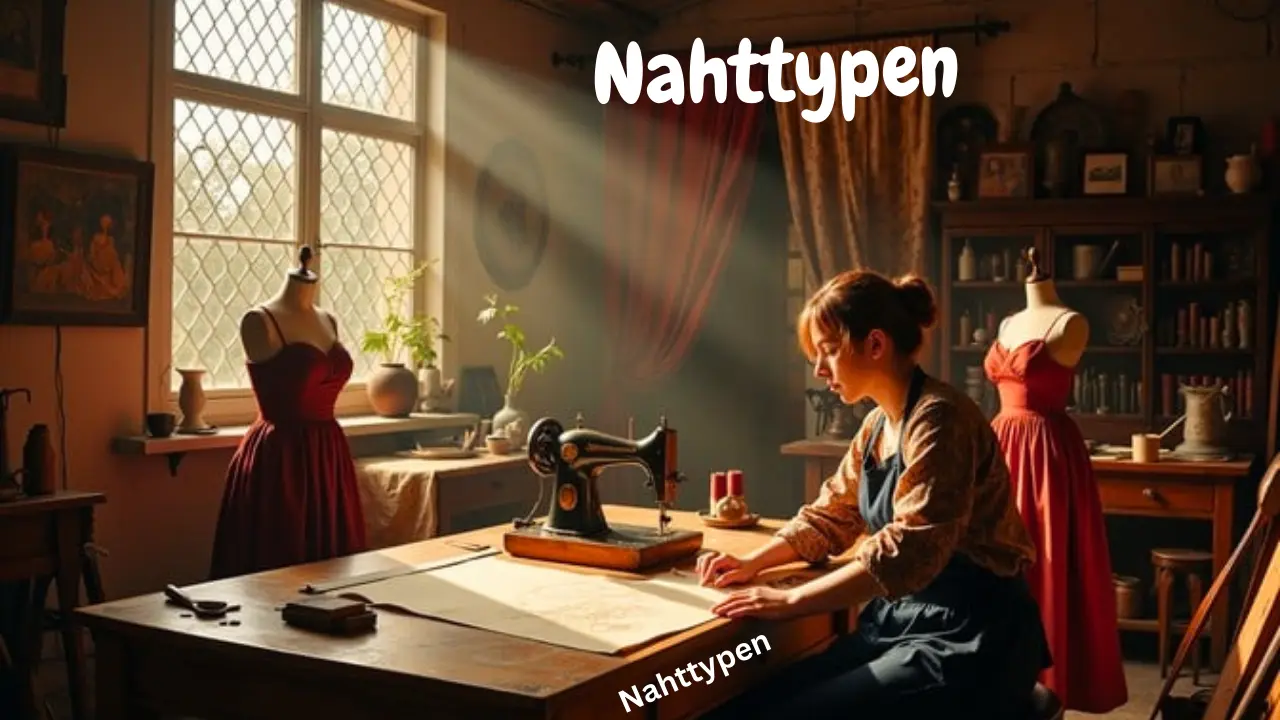When it comes to sewing, garment construction, and textile design, seams are one of the most essential elements. A seam is not just a line of stitching; it holds fabrics together, provides strength, and even influences the final look of a garment. Different types of seams are applied for different materials and purposes, from lightweight fabrics like silk to heavy-duty textiles such as denim. In the world of sewing, these seam variations are known as “Nahttypen“.
Understanding the various Nahttypen is crucial for anyone involved in fashion design, tailoring, upholstery, or even home DIY projects. Each seam type has unique properties, offering different levels of durability, elasticity, or decorative appeal. Choosing the right seam ensures not only the longevity of the garment but also its comfort and overall appearance.
In this article, we will explore the most important Nahttypen, their applications, advantages, and the techniques used to achieve professional results. This comprehensive guide is designed to help beginners, hobbyists, and professionals alike understand the depth and importance of seam types in sewing.
What Are Nahttypen?
The word Nahttypen simply translates to “seam types” in English. Seams are the backbone of textile construction, as they connect two or more pieces of fabric. However, not all seams are created equal. Depending on the type of fabric, the stress the seam will face, and the overall design goal, a specific seam technique must be selected.
Seams can generally serve three purposes:
- Functional – ensuring strength and durability.
- Decorative – adding aesthetic appeal with visible stitches.
- Protective – preventing fabric edges from fraying.
With this in mind, let us examine the most common seam types, their uses, and why choosing the right Nahttypen is so important.
Basic Seam Types
Straight Stitch Seam (Geradstich)
The straight stitch seam is the foundation of all sewing. It is used for basic joining of fabric pieces. This type of seam is suitable for woven fabrics and is the go-to option for everyday sewing tasks.
Uses:
- Basic garment construction.
- Interior seams on non-stretch fabrics.
- Simple home projects like pillow covers.
Zigzag Seam (Zickzacknaht)
A zigzag seam is highly versatile and is often used on fabrics that fray easily. This seam is also flexible, making it ideal for light stretch materials.
Uses:
- Preventing raw edges from fraying.
- Decorative applications.
- Stretch garments such as sportswear.
Professional and Industrial Seam Types
Overlock Seam (Overlocknaht)
The overlock seam is commonly used in mass garment production. It stitches and finishes the edges simultaneously, leaving a clean, professional finish.
Uses:
- T-shirts and knitwear.
- Industrial textile products.
- High-volume clothing manufacturing.
Flatlock Seam (Flatlocknaht)
Flatlock seams are both functional and decorative. The stitches lie flat against the fabric, reducing bulk and allowing flexibility.
Uses:
- Sportswear.
- Underwear.
- Stretch fabrics requiring comfort.
French Seam (Französische Naht)
The French seam encloses raw fabric edges within two rows of stitching, creating a neat and elegant finish. It is best suited for delicate fabrics.
Uses:
- Evening gowns.
- Lightweight fabrics like chiffon or silk.
- Children’s clothing for added durability.
Heavy-Duty Seam Types
Flat-Felled Seam (Kappnaht)
This seam is extremely strong and durable, often used in garments that face heavy wear and tear.
Uses:
- Denim jeans.
- Workwear.
- Outdoor garments requiring extra strength.
Lapped Seam (Überlappnaht)
An overlapping seam that reinforces strength by layering fabric pieces. It is often found in leatherwork and heavy-duty applications.
Uses:
- Leather jackets.
- Industrial fabrics.
- Sturdy upholstery.
Decorative and Specialized Seam Types
Topstitch Seam (Steppnaht)
Topstitching is done on the exterior of garments for both reinforcement and decoration.
Uses:
- Jeans, jackets, and coats.
- Visible hems.
- Adding visual detail to simple garments.
Piped Seam (Paspelnaht)
Piping involves inserting a cord between fabric layers, creating a decorative effect.
Uses:
- Home décor such as cushions.
- Dressmaking for stylistic emphasis.
- Upholstery projects.
Blind Stitch Seam (Blindstich)
This seam is nearly invisible, making it ideal for hems. It can be done by hand or with a special machine setting.
Uses:
- Dress hems.
- Curtains.
- Skirts and trousers.
Basting Seam (Heftnaht)
Basting is a temporary seam that holds fabric in place before permanent stitching.
Uses:
- Trial fittings.
- Complex garments needing adjustment.
- Pre-sewing stabilization.
Decorative Add-Ons in Seams
Besides functional uses, many Nahttypen are employed purely for design. Decorative stitching such as embroidery seams, scalloped edges, and double-needle stitching add elegance and uniqueness to garments. Designers often play with these techniques to elevate a garment’s appearance beyond functionality.
Choosing the Right Seam Type
Selecting the appropriate seam depends on several factors:
- Fabric Type – Stretch fabrics require flexible seams, while woven fabrics need strong, stable seams.
- Garment Purpose – Workwear demands durability, while evening gowns prioritize aesthetics.
- Durability vs. Decoration – Decide whether the seam is purely functional or also a decorative detail.
- Skill Level – Some seams, like the French seam, require precision, while others like the straight stitch are beginner-friendly.
Advantages of Understanding Nahttypen
- Professional Finish: The right seam gives garments a polished and finished look.
- Durability: Correct seam choice ensures the clothing withstands wear and washing.
- Comfort: Some seam types, such as flatlock, reduce irritation against the skin.
- Creativity: Decorative seams expand design possibilities in fashion and home décor.
Step-by-Step Example: Sewing a French Seam
- Place fabric wrong sides together.
- Sew a narrow seam allowance.
- Trim edges to prevent fraying.
- Fold fabric right sides together and sew again, enclosing raw edges.
- Press flat for a neat finish.
This process shows how careful handling of seams enhances both function and appearance.
Common Mistakes When Working with Seams
- Wrong Seam for Fabric: Using a straight stitch on stretch fabric may cause breakage.
- Ignoring Finishing: Leaving raw edges exposed results in fraying.
- Incorrect Tension: Poor machine settings can cause puckering.
- Skipping Pressing: Unpressed seams look bulky and unprofessional.
Conclusion
Seams are more than just functional connections between fabric pieces. They define the strength, look, and quality of a garment. Understanding the different Nahttypen equips every sewer and designer with the skills to make professional and creative choices. From basic straight stitches to decorative piping and strong flat-felled seams, each type serves a unique purpose.
Whether you are a beginner working on small projects or a professional tailoring garments for clients, mastering seam types will elevate your sewing to the next level. By exploring these variations, you not only improve your craftsmanship but also gain the ability to bring creative design ideas to life.
FAQs About Nahttypen
1. What are Nahttypen in sewing? Nahttypen refers to the different seam types used in sewing to join, reinforce, or decorate fabric pieces.
2. Which Nahttypen are best for stretch fabrics? Zigzag, overlock, and flatlock seams are best for stretch fabrics as they allow flexibility and prevent breaking.
3. Why is the French seam popular for delicate fabrics? The French seam encloses raw edges, preventing fraying and giving lightweight fabrics like silk a clean and elegant finish.
4. What Nahttypen are commonly used in jeans? Flat-felled seams and topstitching are widely used in denim jeans for durability and reinforcement.
5. Can decorative seams also be functional? Yes, many decorative seams such as topstitching not only enhance design but also add strength to the garment.
Read More: Buy YouTube Views MySocialFollowing.com: Honest Review and Powerful Growth Guide

